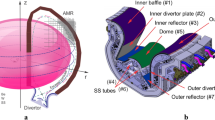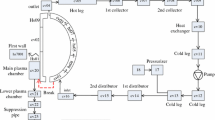Abstract
Fusion specific features like inherent plasma shutdown, low decay heat densities, cryogenic temperatures, and limited source terms were considered during the safety design process of ITER. Uncertainties in plasma disruptions motivates a robust design to cope with multiple failures of in-vessel cooling piping. A vacuum vessel pressure suppression system mitigates pressure transients and effectively captures mobilized radioactivity. In case of pump trips or ex-vessel coolant losses in the divertor the plasma needs to be actively terminated in a few seconds. Failure to do so might damage the divertor but radiological consequences will be minor due to the intact first confinement barrier. Tritium plant inventories are protected by several layers of confinement. Uncontrolled release of magnet energy will be prevented by design. Postulated damage from magnets to confinement barriers causes fluid ingress (air, water, helium) into the cryostat. The cold environment limits pressurization. Most tritium and dust is captured by condensation.
Similar content being viewed by others
REFERENCES
S. Piet, L. Di Pace, G. Federici et al. (1996). Source Term and Mobilization Assessment in NSSR-1. IAEA 6th Technical Committee Meeting on Developments in Fusion Safety, Naka, Japan, October.
N. A. Uckan, S. Putvinski, J. Wesley et al. (submitted). ITER physics-safety interface: Models and assessment. Fusion Technol.
T. Honda, H.-W. Bartels, N. A. Uckan, Y. Seki, and T. Okazaki (submitted). Development of time dependent safety analysis code for plasma anomaly events in fusion reactors. J. Nucl. Sci. Technol.
T. Honda, H.-W. Bartels, N. A. Uckan, T. Okazaki, and Y. Seki (submitted). Safety analysis and in-vessel components transient during plasma abnormal events in fusion reactors. J. Nucl. Sci. Technol.
B. J. Merrill and S. C. Jardin (1991). Coolant ingress induced plasma disruption calculations for ITER. Fusion Technol. 19, 1278-1283.
M. Iseli, H.-W. Bartels, and A. Poucet (1996). Decay Heat Removal by Natural Circulation of Vacuum Vessel Coolant for ITER. IAEA 6th Technical Committee Meeting on Developments in Fusion Safety, Naka, Japan, October.
H.-W. Bartels, E. Cheng, M. J. Gaeta et al. (1996). Decay heat removal in the ITER outline design. Fus. Eng. Design, 31, 203-219.
J. M. Gay (1996). Analysis of the IDR Divertor Response to LOFA and LOCA Transients. DI/SEPS/96-00370, Technicatome, Ets D'Aix Provence, France, March.
Y. Shimomura, R. Aymar, H.-W. Bartels et al. (1996). Safety Characteristics for ITER. IAEA-CN-64/F3, 17th IAEA Fusion Energy Conference, Montreal, Canada, October.
M. J. Gaeta, B. J. Merrill, H.-W. Bartels et al. (submitted). Short term hydrogen production issues for ITER. Fusion Technol.
D. A. Petti et al. (1996). Safety analysis results for ITER in-vessel loss of coolant events. IAEA 6th Technical Committee Meeting on Developments in Fusion Safety, Naka, Japan, October.
B. J. Merrill, L. C. Cadwallader, and D. A. Petti (1996). Safety analysis results for cryostat ingress accidents in ITER. IAEA 6th Technical Committee Meeting on Developments in Fusion Safety, Naka, Japan, October.




